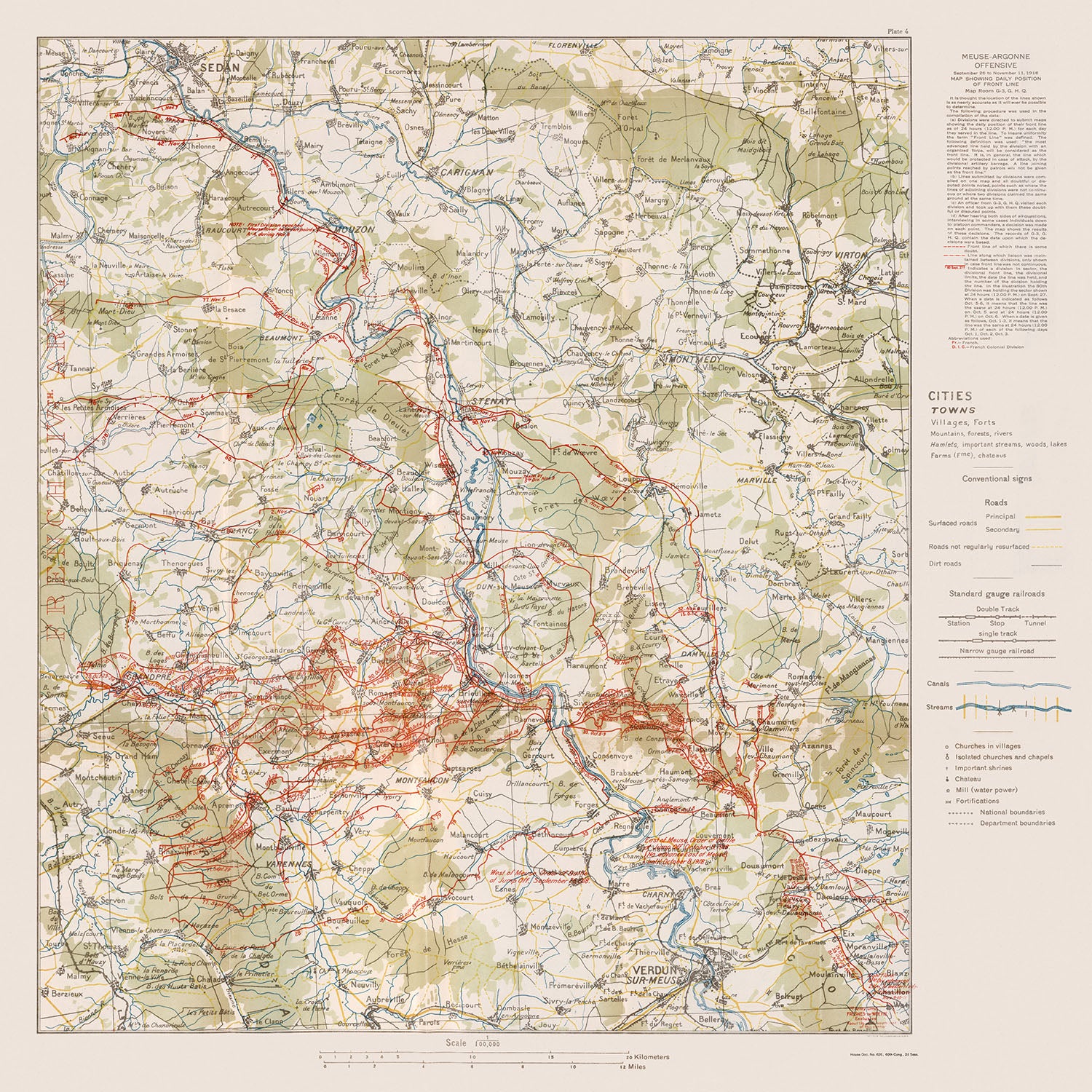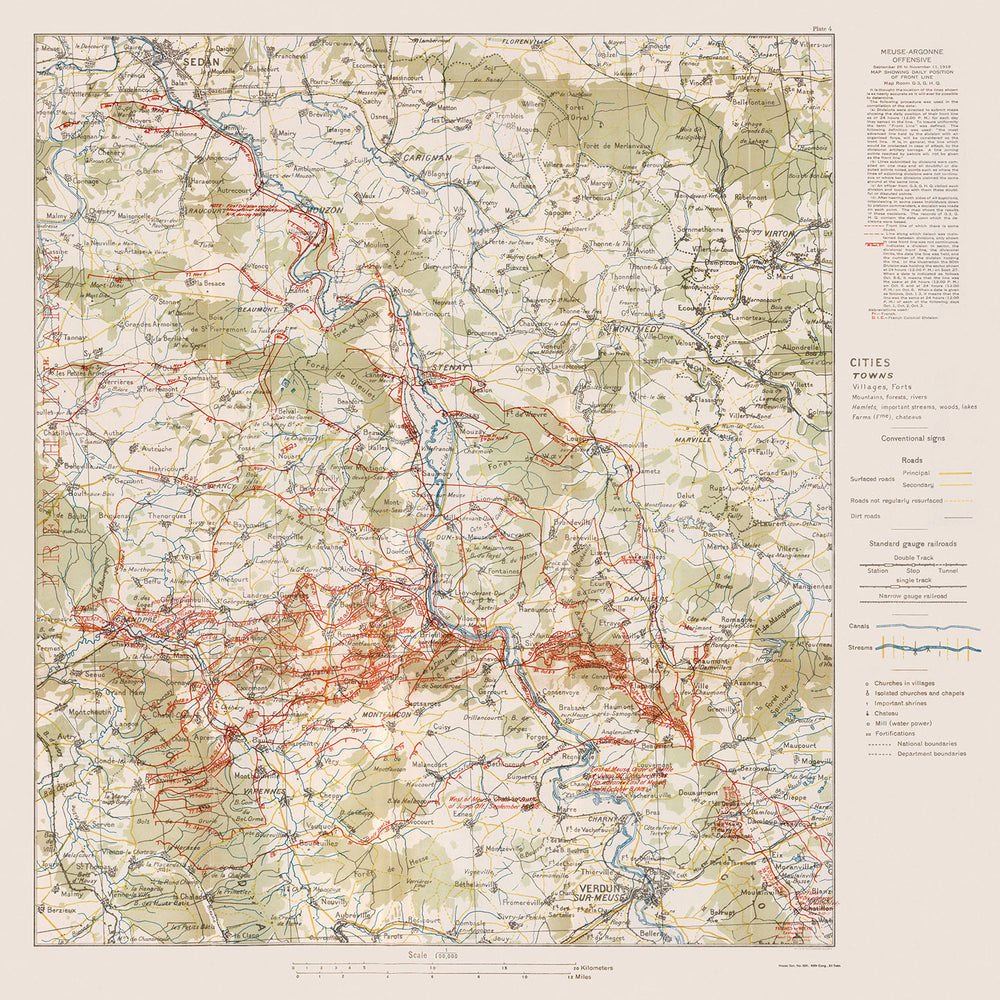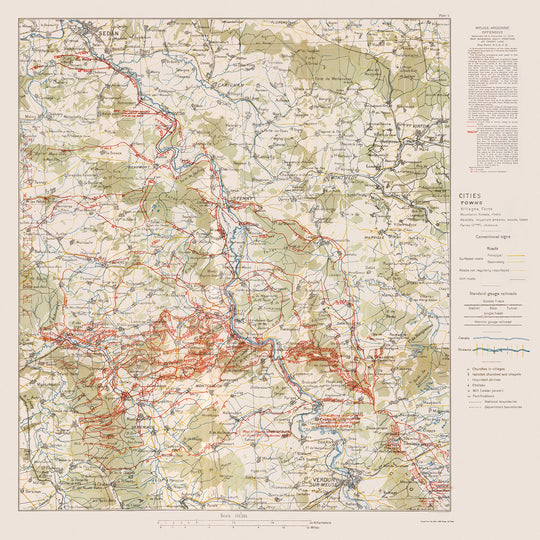- Handmade locally. No import duty or tax
- FREE Delivery by Christmas
- Love it or your money back (90 days)
- Questions? WhatsApp me any time
Own a piece of history
5,000+ 5 star reviews


Immerse yourself in a pivotal moment of World War I with this meticulously detailed map of the Meuse-Argonne Offensive, created by General John J. Pershing in 1918. This map, featured in Pershing's final report and published by the Government Printing Office in 1920, offers a vivid portrayal of the daily positions of the front line during one of the most significant military operations of the war. The Meuse-Argonne Offensive, which spanned from September 26 to November 11, 1918, was a crucial Allied push that ultimately led to the Armistice and the end of the war. This map is not just a representation of geography but a chronicle of strategic maneuvers and heroic efforts.
The map encompasses the Meuse and Argonne regions of France, illustrating the intricate network of political boundaries, cities, forts, and other critical landmarks. It captures the essence of the battlefield with detailed depictions of railways, roads, canals, and topographical features such as forests and bodies of water. The inclusion of churches, mills, and drainage patterns adds a layer of depth, providing insight into the terrain and the challenges faced by the troops. The legend and explanatory notes enhance the map's utility, making it an indispensable tool for understanding the complex dynamics of the offensive.
What sets this map apart is its historical significance and the context it provides about the American Expeditionary Forces' operations in Europe. Under Pershing's command, the AEF played a decisive role in the Meuse-Argonne Offensive, which was one of the largest and deadliest campaigns involving American troops. The map's detailed indexing of military jurisdictions and daily front line positions offers a unique glimpse into the strategic planning and execution of the offensive. It serves as a testament to the bravery and resilience of the soldiers who fought in this crucial battle.
The map also highlights significant places where important events occurred, such as Verdun, Montfaucon, and Sedan, along with other notable locations like Romagne, Cunel, and Brieulles. These sites were key to the success of the offensive and are marked with precision, allowing historians and enthusiasts to trace the movements and engagements of the Allied forces. The depiction of routes, trails, and camps further enriches the narrative, providing a comprehensive overview of the logistical and tactical elements that defined the campaign.
Owning this map is like holding a piece of history in your hands. It is a valuable artifact that not only documents a critical chapter in World War I but also serves as a tribute to the strategic brilliance and valor of the American Expeditionary Forces. Whether you are a history aficionado, a military enthusiast, or a collector of rare maps, this exquisite piece offers an unparalleled opportunity to delve into the past and explore the intricacies of one of the most significant military operations of the 20th century.
Places on this map
- Verdun
- Montfaucon
- Sedan
- Romagne
- Cunel
- Brieulles
- Apremont
- Sivry-sur-Meuse
- Dun-sur-Meuse
- Exermont
- Châtillon-sur-Bar
- Charpentry
- Fleville
- Bantheville
- Cierges
- Landres-et-Saint-Georges
- Barricourt
- Andevanne
- Cléry-le-Grand
- Consenvoye
Notable Features & Landmarks
- Political boundaries of the Meuse and Argonne regions
- Cities such as Verdun, Montfaucon, and Sedan
- Forts and military positions
- Churches and mills
- Railways and roads, including surface roads and main roads
- Canals and bodies of water, including rivers and streams
- Topographical features such as forests and elevation changes
- Daily front line positions during the Meuse-Argonne Offensive
- Military jurisdictions indexed on the map
- Legend explaining symbols and features
- Bar scales in kilometers and miles
- Drainage patterns and water bodies
- Explanatory notes providing additional context
- Key battle sites and movements
- Significant routes and trails used during the offensive
- Major cities and their strategic importance
- Historic landmarks relevant to the offensive
- Camps and military installations
- Notable events and battles occurring in the depicted regions
- Villages and smaller towns in the operational area
- Surface roads and their conditions
- Standard gauge railroads and their importance
- Double-track railroads for military logistics
- Narrow gauge railroads for specific tactical uses
- Canals used for transportation and supply routes
- Streams and their impact on military operations
- Forested areas and their strategic significance
Historical and design context
- Name of the map: Military map of Meuse and Argonne, France, during World War I
- Featured in the final report of Gen. John J. Pershing
- Published by the Government Printing Office in Washington D.C., 1920
- Depicts the daily position of the front line in the "Meuse-Argonne Offensive" of 1918
- Shows political boundaries, cities, forts, churches, mills, railways, roads, canals, topography, forests, bodies of water, and drainage
- Includes a legend, explanatory notes, and two bar scales given in kilometers and miles
- Indexed to indicate military jurisdictions
- Created by John J. Pershing, commander of the American Expeditionary Forces during World War I
- The Meuse-Argonne Offensive was a major part of the final Allied offensive of World War I
- One of the largest operations of the American Expeditionary Forces in World War I, leading to the Armistice of November 11, 1918
Please double check the images to make sure that a specific town or place is shown on this map. You can also get in touch and ask us to check the map for you.
This map looks great at every size, but I always recommend going for a larger size if you have space. That way you can easily make out all of the details.
This map looks amazing at sizes all the way up to 90in (230cm). If you are looking for a larger map, please get in touch.
Please note: the labels on this map are hard to read if you order a map that is 20in (50cm) or smaller. The map is still very attractive, but if you would like to read the map easily, please buy a larger size.
The model in the listing images is holding the 16x16in (40x40cm) version of this map.
The fifth listing image shows an example of my map personalisation service.
If you’re looking for something slightly different, check out my collection of the best old maps to see if something else catches your eye.
Please contact me to check if a certain location, landmark or feature is shown on this map.
This would make a wonderful birthday, Christmas, Father's Day, work leaving, anniversary or housewarming gift for someone from the areas covered by this map.
This map is available as a giclée print on acid free archival matte paper, or you can buy it framed. The frame is a nice, simple black frame that suits most aesthetics. Please get in touch if you'd like a different frame colour or material. My frames are glazed with super-clear museum-grade acrylic (perspex/acrylite), which is significantly less reflective than glass, safer, and will always arrive in perfect condition.
This map is also available as a float framed canvas, sometimes known as a shadow gap framed canvas or canvas floater. The map is printed on artist's cotton canvas and then stretched over a handmade box frame. We then "float" the canvas inside a wooden frame, which is available in a range of colours (black, dark brown, oak, antique gold and white). This is a wonderful way to present a map without glazing in front. See some examples of float framed canvas maps and explore the differences between my different finishes.
For something truly unique, this map is also available in "Unique 3D", our trademarked process that dramatically transforms the map so that it has a wonderful sense of depth. We combine the original map with detailed topography and elevation data, so that mountains and the terrain really "pop". For more info and examples of 3D maps, check my Unique 3D page.
For most orders, delivery time is about 3 working days. Personalised and customised products take longer, as I have to do the personalisation and send it to you for approval, which usually takes 1 or 2 days.
Please note that very large framed orders usually take longer to make and deliver.
If you need your order to arrive by a certain date, please contact me before you order so that we can find the best way of making sure you get your order in time.
I print and frame maps and artwork in 23 countries around the world. This means your order will be made locally, which cuts down on delivery time and ensures that it won't be damaged during delivery. You'll never pay customs or import duty, and we'll put less CO2 into the air.
All of my maps and art prints are well packaged and sent in a rugged tube if unframed, or surrounded by foam if framed.
I try to send out all orders within 1 or 2 days of receiving your order, though some products (like face masks, mugs and tote bags) can take longer to make.
If you select Express Delivery at checkout your order we will prioritise your order and send it out by 1-day courier (Fedex, DHL, UPS, Parcelforce).
Next Day delivery is also available in some countries (US, UK, Singapore, UAE) but please try to order early in the day so that we can get it sent out on time.
My standard frame is a gallery style black ash hardwood frame. It is simple and quite modern looking. My standard frame is around 20mm (0.8in) wide.
I use super-clear acrylic (perspex/acrylite) for the frame glass. It's lighter and safer than glass - and it looks better, as the reflectivity is lower.
Six standard frame colours are available for free (black, dark brown, dark grey, oak, white and antique gold). Custom framing and mounting/matting is available if you're looking for something else.
Most maps, art and illustrations are also available as a framed canvas. We use matte (not shiny) cotton canvas, stretch it over a sustainably sourced box wood frame, and then 'float' the piece within a wood frame. The end result is quite beautiful, and there's no glazing to get in the way.
All frames are provided "ready to hang", with either a string or brackets on the back. Very large frames will have heavy duty hanging plates and/or a mounting baton. If you have any questions, please get in touch.
See some examples of my framed maps and framed canvas maps.
Alternatively, I can also supply old maps and artwork on canvas, foam board, cotton rag and other materials.
If you want to frame your map or artwork yourself, please read my size guide first.
My maps are extremely high quality reproductions of original maps.
I source original, rare maps from libraries, auction houses and private collections around the world, restore them at my London workshop, and then use specialist giclée inks and printers to create beautiful maps that look even better than the original.
My maps are printed on acid-free archival matte (not glossy) paper that feels very high quality and almost like card. In technical terms the paper weight/thickness is 10mil/200gsm. It's perfect for framing.
I print with Epson ultrachrome giclée UV fade resistant pigment inks - some of the best inks you can find.
I can also make maps on canvas, cotton rag and other exotic materials.
Learn more about The Unique Maps Co.
Map personalisation
If you're looking for the perfect anniversary or housewarming gift, I can personalise your map to make it truly unique. For example, I can add a short message, or highlight an important location, or add your family's coat of arms.
The options are almost infinite. Please see my map personalisation page for some wonderful examples of what's possible.
To order a personalised map, select "personalise your map" before adding it to your basket.
Get in touch if you're looking for more complex customisations and personalisations.
Map ageing
I have been asked hundreds of times over the years by customers if they could buy a map that looks even older.
Well, now you can, by selecting Aged before you add a map to your basket.
All the product photos you see on this page show the map in its Original form. This is what the map looks like today.
If you select Aged, I will age your map by hand, using a special and unique process developed through years of studying old maps, talking to researchers to understand the chemistry of aging paper, and of course... lots of practice!
If you're unsure, stick to the Original colour of the map. If you want something a bit darker and older looking, go for Aged.
If you are not happy with your order for any reason, contact me and I'll get it fixed ASAP, free of charge. Please see my returns and refund policy for more information.
I am very confident you will like your restored map or art print. I have been doing this since 1984. I'm a 5-star Etsy seller. I have sold tens of thousands of maps and art prints and have over 5,000 real 5-star reviews. My work has been featured in interior design magazines, on the BBC, and on the walls of dozens of 5-star hotels.
I use a unique process to restore maps and artwork that is massively time consuming and labour intensive. Hunting down the original maps and illustrations can take months. I use state of the art and eye-wateringly expensive technology to scan and restore them. As a result, I guarantee my maps and art prints are a cut above the rest. I stand by my products and will always make sure you're 100% happy with what you receive.
Almost all of my maps and art prints look amazing at large sizes (200cm, 6.5ft+) and I can frame and deliver them to you as well, via special oversized courier. Contact me to discuss your specific needs.
Or try searching for something!
















































